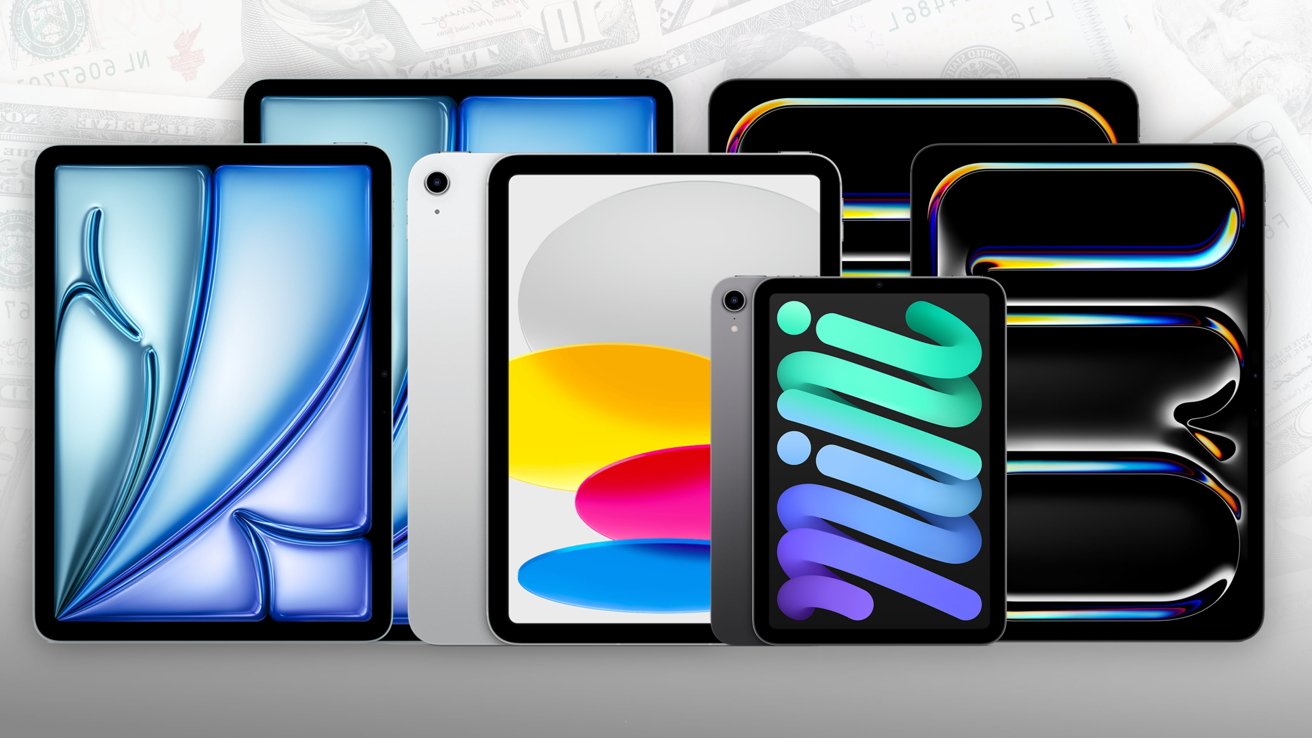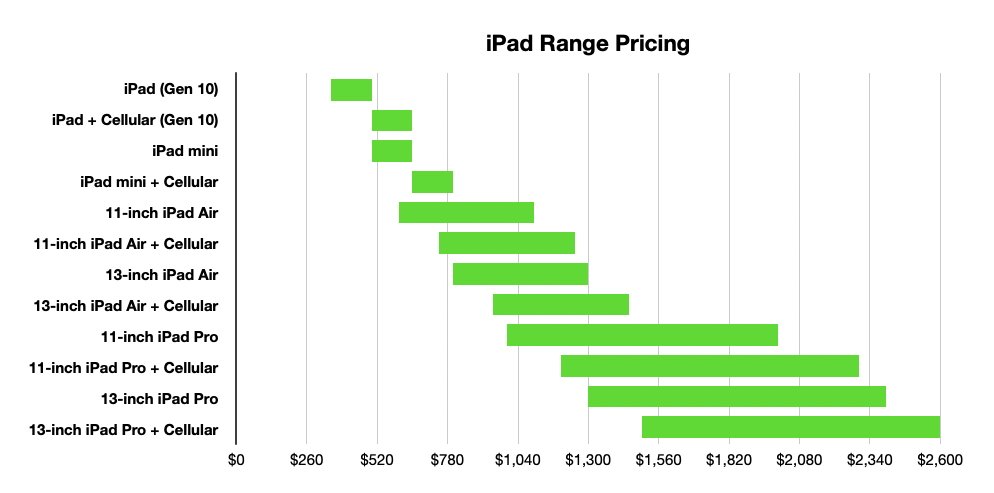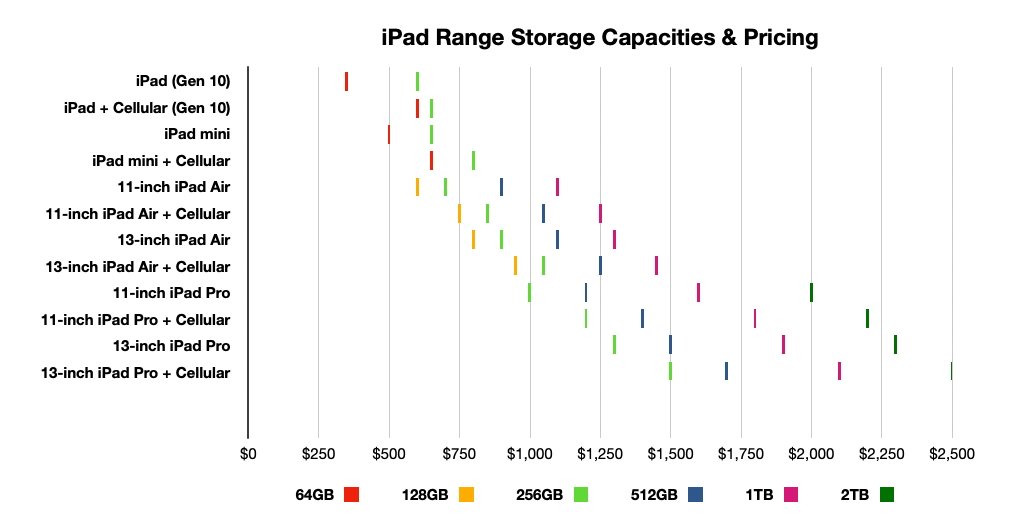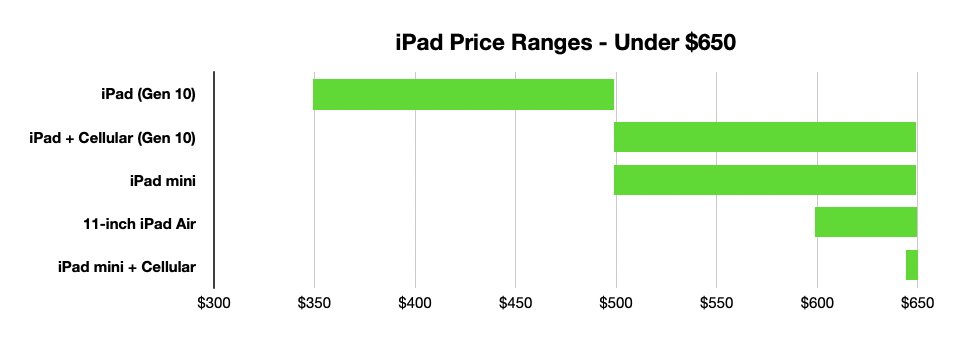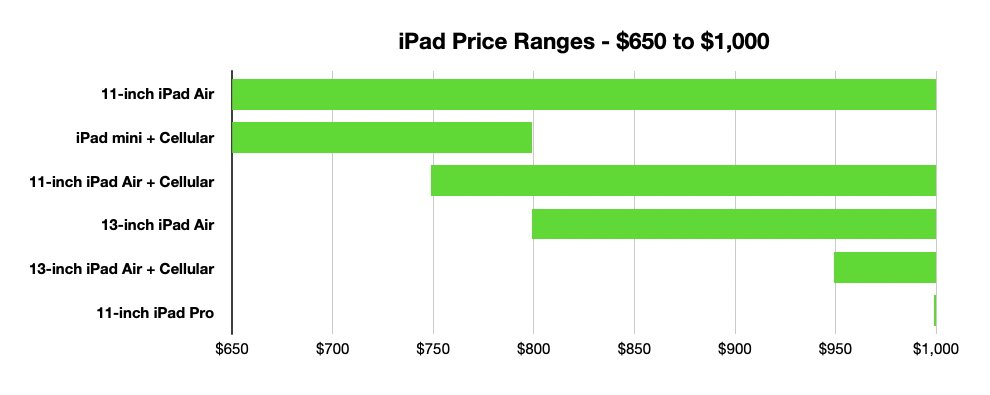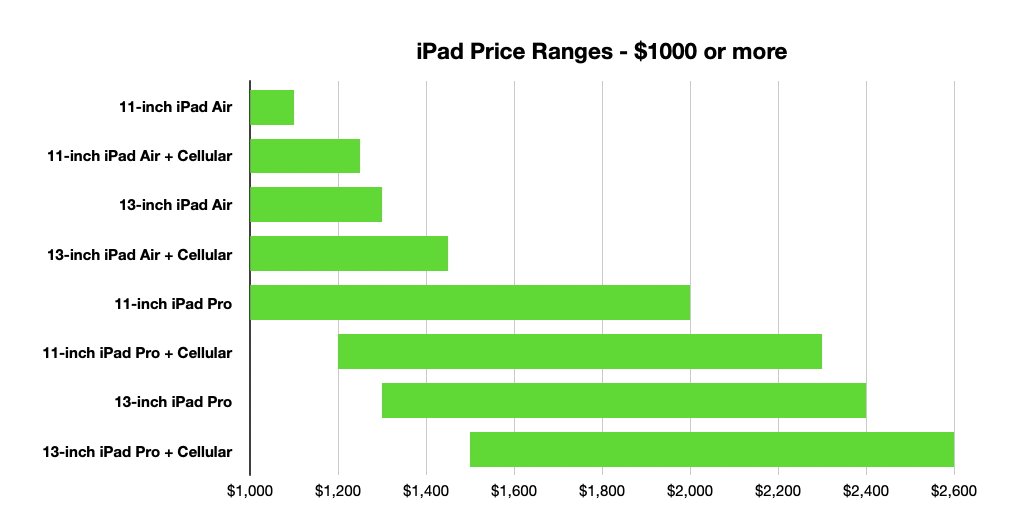Apple’s iPad lineup is now radically different than it was at this time in 2023. Here’s how to choose the best tablet to buy for your budget.
Across all of Apple’s product ranges it offers products over a very wide selection of price points. If you have a particular budget in mind, there’s an iPad to match.
However, unlike its other product categories, the iPad range was stagnant in 2023. There were no updates at all that year, and the drought continued until May 2024.
The latest changes have seen Apple make considerable updates to its iPad Air and iPad Pro lineup. At the same time, it adjusted the budget end of the spectrum by discontinuing the 9th-gen iPad and turning the tenth-gen model into the new entry-level edition.
The changes means there are still a lot of products for customers to choose from at first glance. But, if you look at it from the viewpoint of how much you want to spend, it gets a lot easier to choose your ideal iPad.
Best iPad – Overall price ranges
If you look at the entire range, Apple has managed to cover every possible price point from $349 to $2,599 with an iPad model.
The 10th-gen iPad is the cheapest option in the range, while the latest 12.9-inch iPad Pro with Cellular is the most expensive, tipping the scales at $2,599 with the highest capacity option and Nano-texture glass.
There’s a difference of $2,250 between the cheapest iPad and the most expensive. The price difference is enough that you could acquire six of the cheapest possible iPad Gen 10 models for less than the cost of the most expensive iPad Pro configuration, and still have around $155 left over.
Looking at the scale from afar, you can feasibly split the catalog into three general sections: The sub-$650 value end, The post-$1,000 iPad Pro era, and the middle $650 to $1,000 range.
This article will be broken up into sections covering each of the three ranges.
Best iPad – Storage, cellular, and Nano-texture concerns
There are many features of each iPad model to consider when selecting which version to buy, but there are two distinct areas to bear in mind when considering all of the trade-offs between models. The size of the ranges is determined by cellular connectivity and storage capacity.
Apple offers versions of its iPads as having only Wi-Fi connectivity or additional cellular service. However, the importance of Internet connectivity has led to the cellular option being a more significant consideration than before, potentially at a par with storage.
Some people may value having Internet access wherever they are more than bumping up storage. Others may not want the extra expense of cellular, which goes beyond the upgrade itself and into paying for cellular plans.
Of course, you could rely on an iPhone or another device to serve as a personal hotspot if you want the benefits of cellular without paying for the upgrade. This does, however, pass any data plan-related costs to your smartphone’s plan, as well as using extra power via the hotspot-hosting device.
Even so, these could be considered a reasonable compromise.
For ease of comparison, we are classifying the cellular-equipped models as a separate variant, costing between $130 and $200 to upgrade from the non-cellular version.
The more significant element that varies the cost is storage, as the more you buy, the more the iPad will cost. The need for storage can also be a factor in determining whether to go for the higher model, as the extra features may not necessarily benefit the user as much as having more capacity on hand.
Handily, Apple has made the storage question simple for the iPad range, even more so than what it does for its iPhone catalog. For all non-Pro and non-Air models, Apple has limited capacities down to two options: 64GB and 256GB.
On the Air range, Apple still offers a lot of choices, with four options between 128GB and 1TB. The Pro models jump up one step further, ranging from 256GB to 2TB.
Arguably, these models can justify the extra capacity options over the non-Pro tablets.
This does discount the idea of using cloud storage as extra off-iPad capacity, which could be helpful for those with extensive photo collections.
There is one other factor that can affect the price of the iPad Pro but not other models.
Borrowed from the Pro Display XDR, Apple has added the option to use Nano-texture glass. The texture is intended to help reduce glare on the screen.
The add-on is an extra $100 charge for those who take it, but only on the 1TB and 2TB capacities.
Best iPad — Under $650
The budget-friendly end of the scale is relatively easy to understand. At the very bottom of the scale, you only really have one choice.
The 10th-gen iPad is the entry-level option at $349 for its 64GB capacity. Though that changes when you get to $499.
At that point, you can get the 256GB iPad, the 64GB with cellular, or the 64GB iPad mini. Unless you want to avoid tethering to an iPhone or you really want a smaller device, you’ll find the 256GB iPad’s a safe bet.
At $599, you could go for the aforementioned 256 iPad with cellular or the 64GB iPad mini, but you could get the M2-equipped 11-inch iPad Air instead. You do get a healthy 128GB of capacity along with the performance boost, so it’s a strong choice to make.
Reaching the top end of the scale, you have the 256GB capacities of cellular iPad and the iPad mini, the same 128GB iPad Air for $50 cheaper. The iPad mini with cellular makes an appearance here, but in its 64GB capacity.
While storage size is a concern, the iPad mini’s size and cellular may be the best pick of the bunch at this price. Unless you need the 11-inch iPad Air’s performance.
Best iPad – $650 to $1,000
The middle of the range starts where we left off at $649, but the first real thing to notice happens at $699. The 11-inch iPad Air gets its upgrade to 256GB.
At $749, another new entry arrives in the form of the 128GB 11-inch iPad Air with cellular. It’s against the 256GB iPad Air without cellular and the cheaper 64GB iPad mini with cellular. The Air with cellular is probably the best all-rounder here.
At $799, the 13-inch iPad Air enters the fray in its 128GB form. This price point also sees the entry of the 256GB version of the iPad min with cellular, but you could still save $100 for the 256GB 11-inch iPad Air.
With the 11-inch iPad Air with cellular reaching 256GB by $899, it becomes arguably the best option. Unless you want the 13-inch iPad Air with 256GB of storage, or a 512GB 11-inch iPad Air, that is.
At $949, the 13-inch iPad Air with cellular becomes a contender, albeit with 128GB of storage. At this level, the 11-inch iPad Air with or without cellular, or the non-cellular 13-inch iPad Air, are still probably better choices due to their storage levels.
Moving to the higher end of this sub-category, $999 can net you a lot for your money. You’d be saving $100 if you go for the 512GB 11-inch Air or 256GB 13-inch iPad Air, $150 for the 256GB cellular 11-inch iPad Air.
However, you could always skew upward to the next step up and go for the iPad Pro. The 11-inch iPad Pro’s base configuration starts at this price point, complete with its OLED display improvements, M4 chip, and a healthy 256GB of storage.
At this price point, shifting up to the Pro leagues is extremely viable.
Best iPad – $1,000 or more
This region is largely dominated by the iPad Pro models. Even so, high-capacity cellular options of earlier versions are still a possibility depending on your needs.
At $1,049, you could have the cellular 11-inch iPad Air at 512GB, or the 13-inch iPad Air with Cellular at 256GB. You could save $50 and get the entry-level 11-inch iPad Pro, which may be better overall.
For $50 more at $1,099, there are the non-cellular 11-inch and 13-inch iPad Air models at 1TB and 512TB respectively. Unless you need masses of storage, you should consider either the cellular iPad Airs that are slightly cheaper, or get the base 11-inch iPad Pro.
When we reach $1,199, the cellular 11-inch iPad Pro becomes an option, complete with 256GB of storage. You could get the 512GB non-cellular version for the same money.
$1,249 brings the cellular 13-inch iPad Air to 512GB and the cellular 11-inch iPad Air to 1TB. Again, its screen size or capacity, but the iPad Pro line is still arguably the best route forward.
When the 13-inch iPad Air reaches its 1TB capacity option at $1,299, it has to compete against the above cheaper cellular options, as well as a new competitor. The 13-inch iPad Pro arrives at this point, albeit with 256GB of storage.
That 13-inch iPad Pro would be decent enough, but remember you could save $100 and get double the capacity with the 11-inch version. Or save $50 and get the 13-inch iPad Air with cellular and 512GB of storage.
At $1,449, the last iPad Air configuration becomes an option, with 1TB of storage in th 13-inch model. For just $50 more, you can get the 13-inch iPad Pro with cellular at 256GB, or a 13-inch iPad Pro with 512GB.
After this price point, there are only iPad Pro models available, meaning your only real concerns are screen size, capacity, and cellular. For the 1TB and 2TB models, you could pay an extra $100 to add Nano-texture glass, which improves image quality.
You reach the top end of the 11-inch iPad Pro by $1,999, or $2,099 if you spring for the Nano-texture glass, with 2TB of storage. At that level, you could get a cellular version with Nano-texture glass and 1TB of storage for $1,899, a 13-inch iPad Pro with 1TB and the glass for $1,999, or the 13-inch with cellular and 1TB for $2,099.
The scale continues until $2,299, when the 11-inch iPad Pro with cellular maxes its storage at 2TB and employs the Nano-texture glass. For the same money, the 13-inch iPad Pro is also at 2TB without the glass, and the 13-inch with cellular and the glass is $100 cheaper.
The 13-inch iPad Pro sans cellular exits the chat at $2,399, again with 2TB of capacity and the glass treatment. Again, its a $200 saving to get the cellular equivalent with 1TB and Nano-texture.
Eventually, at a nose bleed-inducing $2,599, the 13-inch iPad Pro with cellular reaches its top configuration of 2TB and the aforementioned glass.
Best iPad — How to pick your tablet
Picking the best tablet is always going to be hard when you have a lot of variants available. With Apple’s product lineup, that’s certainly the case when you get to the middle of the range.
Going for higher performance options is usually a good idea, but you really should actually have a need for it. If the iPad’s going to be your primary computing device, it does make sense to pay for upper-tier models.
For quite a lot of use cases, the basic iPad can handle most of the average user’s everyday tasks.
Screen size is always going to be a factor, and you have three to choose from: the iPad mini, 11 inches, or 13 inches. We’ve found that larger tablet sizes tend to be more useful for productivity and content creation, so erring towards the 13-inch could be a good idea here.
Cellular is arguably the most disposable feature of the lot, since you could simply tether off an iPhone or a mobile hotspot if local Wi-Fi isn’t available. The price difference could be enough to cover the cost of other feature upgrades.
Storage is the biggest price variant, and it’s not a linear jump. The cost increase is negligible at the low end, but it can certainly add a lot to the price.
That said, you should ask yourself if you really need 2TB of storage in an iPad Pro. You could save $400 and have 1TB, which an entirely usable amount of storage, even for professional uses.
Considering what features to fall back on could help you when it comes to AppleCare+ and accessories. Often forgotten about when pricing out a new iPad, these extras add to the overall cost, but can be very handy.
Where to buy Apple’s iPad
The best prices across Apple’s range of iPads can be found in our iPad Price Guide, with exclusive deals on the new 2024 iPad Air 6 and M4 iPad Pro models.
You can compare prices on current and closeout models, as well as set price alerts (if you aren’t quite ready to buy) within the Price Guides to aid you in getting the best deal on any model. And speaking of deals, we also highlight the best promotions in our iPad Deals Roundup.


